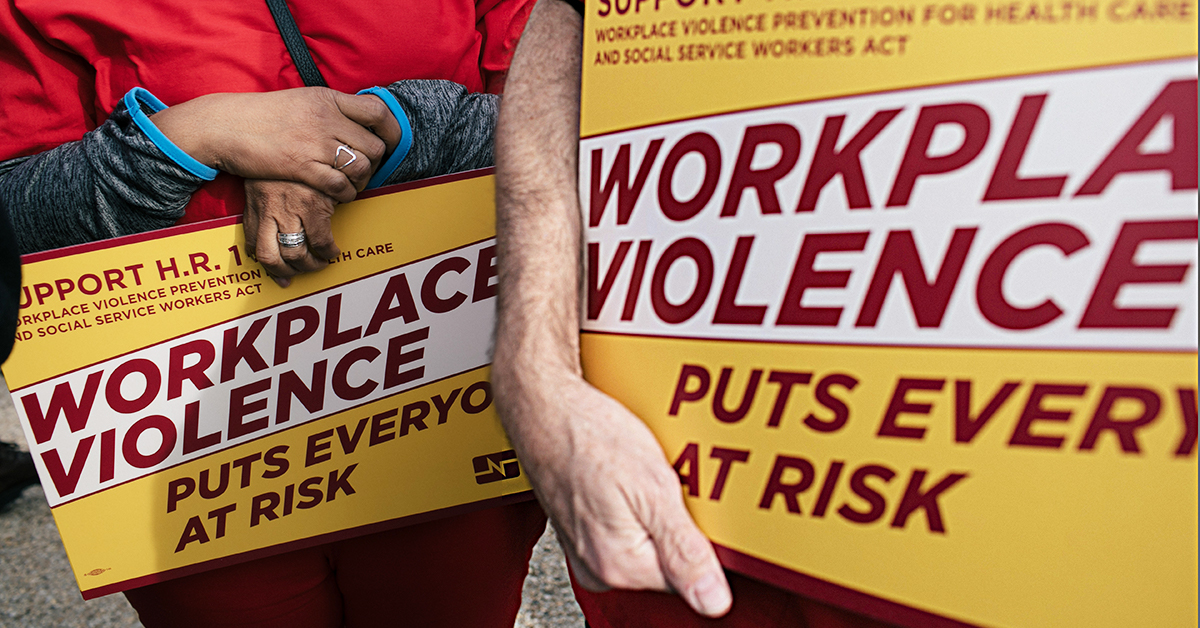Examining the Impact of the Cal/OSHA Workplace Violence Prevention Standard

California Nurses Association/National Nurses United (CNA/NNU) won hallmark legislation on workplace violence prevention in health care settings in 2014. Because of nurses’ powerful organizing and advocacy, Cal/OSHA’s Workplace Violence Prevention in Health Care Standard now requires California health care employers to implement comprehensive, unit-specific workplace violence prevention plans.
Since it went fully into effect in 2018, CNA/NNU members have tirelessly enforced the Cal/OSHA Workplace Violence Prevention Standard to hold their employers accountable and win safer working conditions in their facilities. CNA/NNU interviewed nurses and examined data to document the impacts of nurses’ advocacy and the effectiveness of workplace violence interventions won by nurses.
Case Studies: Impacts of Workplace Violence Prevention Measures Won by CNA/NNU Members Enforcing the Cal/OSHA Workplace Violence Prevention Standard
CNA/NNU members organized and won significant safety improvements at Kaiser San Francisco a serious workplace violence incident occurred in July 2019. Results demonstrate the effectiveness of interventions formulated by union RNs in reducing workplace violence incidents and injuries.
CNA/NNU members organized and won significant safety improvements at UCLA beginning in January 2020. Prevention measures formulated by RNs increased awareness and recognition of workplace violence among staff, which consequently increased reporting of violent incidents—an essential aspect of effective workplace violence prevention plans.
The origin of Cal/OSHA’s Workplace Violence Prevention Standard
The death of an RN and CNA/NNU member, Cynthia Palomata, in 2010 after a preventable workplace violence incident was a galvanizing moment for nurses. CNA/NNU called for urgent reforms to address the disturbing trend of increasing violence in health care facilities. According to the Bureau of Labor Statistics, RNs in the private sector experience violence-related injuries at rates higher than any other industry. Between 2011 to 2016, 58 hospital workers died as a result of violence in their workplace.
With a renewed sense of urgency to protect RNs and other healthcare workers, California adopted comprehensive legislation in 2014. Nurses engaged in this campaign in record numbers from facilities across the state. As a result of this advocacy, nurses won the Cal/OSHA Workplace Violence Prevention Standard, which requires all hospitals and health care employers to have a workplace violence prevention plan in place.
The continued fight by California nurses for safe health care facilities
Following the passage of SB 1299, nurses have continued to fight for safe workplaces by holding their employers accountable and ensuring the implementation of workplace violence protections for health care workers. Through collective action and the power of the union, CNA/NNU nurses have guaranteed that the best available interventions are adopted and enforced. Examples of protections won by nurses include:
- Badge access to all clinic areas and increased video security cameras.
- Increased communication with security via programed speed dial on phones or badge security buttons.
- Institution of systems to indicate patients who have been identified as presenting potential security risks (e.g. through electronic medical records or signage outside of patient rooms).
- Provision of training courses on workplace violence prevention and de-escalation tactics.
Read the above case studies for additional details.
The fight for a national workplace violence prevention standard
The reality is that workplace violence protections are needed in health care facilities across the country. NNU is leading the campaign to win a national workplace violence prevention standard that would require health care employers in every state to implement comprehensive, unit-specific plans created with direct care RN input. You can learn more about NNU’s campaign here.